Milk and Cookies To Go: A New Packaging Concept Is Born
"Dashboard dining." That's what Bill Weber, president and general manager of Emergent Technologies, calls today's penchant for on-the-go eating.
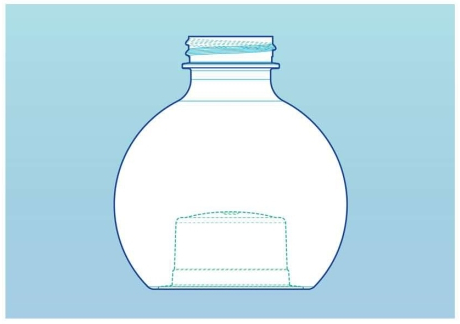 Emergent describes itself as a business incubation services company that takes ideas from concept to commercialization. In this case, the company's extensive research into our eating habits — from rising obesity rates and the latest dietary guidelines to on-the-go food consumption — sparked the idea of creating a two compartment container for compatible food products.
Emergent describes itself as a business incubation services company that takes ideas from concept to commercialization. In this case, the company's extensive research into our eating habits — from rising obesity rates and the latest dietary guidelines to on-the-go food consumption — sparked the idea of creating a two compartment container for compatible food products.
Every time Weber explains the concept and uses the example of a container filled with cold milk and cookies, everyone smiles. And so, this first-of-its-kind, polyethylene terephtalate (PET) product has been named the Smiler.
In a recent press release, he says, "Less than 20 percent of all Americans use vending machines regularly, because they don't like the extra cost and calories that typically come with full-size vended products. Our research shows that a sizable number of consumers like the idea (and functionality) of getting a little less snack and a little less beverage for less that the cost of two full-size products. With all the on-the-go eating we see today, people seem to like the idea of popular snack-and-drink combos that can simply 'tide them over' until they can sit down for a real meal."
This simple concept presented some challenging design problems — in particular how to make a base cavity that was deep enough to hold the second snack. So Emergent turned to an expert in plastic packaging — Plastic Technologies, Inc (PTI), headquartered in Holland, Ohio.
 |
 |
We spoke with Ron Puvak, PTI's director of business development/marketing and Tracy Momany, vice president of product development, about their work on the Smiler and more generally, how they use advanced digital manufacturing techniques to design everything from Eggo Syrup containers to bottles of good ole Mountain Dew.
At this point the Smiler project is still in the concept stage. Puvak says that a lot of interest has been generated by the design.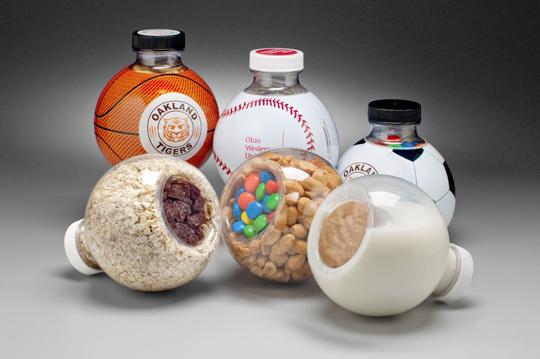
PTI is actively engaged in several customer projects that are still under wraps and experiencing keen interest from what Puvak characterizes as "some surprising segments."
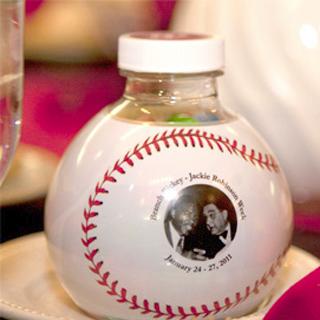 Containers have already been produced for promotional events. For example, a ball-shaped bottle was used by Ohio Wesleyan University to help commemorate the signing of baseball legend Jackie Robinson to the Brooklyn Dodgers by Branch Rickey (OWU '04). Now Emergent and PTI are bringing the Smiler to the attention of mainstream brand owners aiming to tap into the on-the-go market.
Containers have already been produced for promotional events. For example, a ball-shaped bottle was used by Ohio Wesleyan University to help commemorate the signing of baseball legend Jackie Robinson to the Brooklyn Dodgers by Branch Rickey (OWU '04). Now Emergent and PTI are bringing the Smiler to the attention of mainstream brand owners aiming to tap into the on-the-go market.
From Concept to Reality
According to Momany, "We used 3D modeling to design a number of physical prototypes in order to optimize the design. The prototypes also helped Bill Weber. When he is trying to sell a new idea into the market, having something people can hold in their hands is really important. We also provided him with renderings that indicated how this concept could potentially evolve to meet a wide variety of customer requirements."
It took over a year to bring the container to its present stage of development. PTI designers investigated both the container itself and the blow molding process used to manufacture the product. As they had anticipated, the base cavity design was the biggest stumbling block. Early in the process, the depth of the base cavity caused the bottle to hang up in the mold.
Working with the PET materials also presented its share of challenges. "This is a tough geometry," Momany says. "Early on we had to establish a set of guidelines based on the geometries involved — for example, how deep the cavity can be, how big the package has to be around the base cavity, and how thin we can make the container walls and still retain structural integrity."
The next step is to start working with customers lined up by Emergent. "Some of the food manufacturers will want the beverage container shaped like their existing product with the addition of the cavity underneath the bottle," she continues. "That's when we will use finite element analysis (FEA) software running on our high-end in-house workstation to try out a number of models in virtual space and create an optimized design."
Modeling and simulation for design optimization is just one of the ways that high performance computing (HPC) is leveraged at PTI. "HPC is part of every development we do," says Momany. "This includes simulating the blow molding process as well as every other step in the product lifecycle process — from the product's conception to its delivery to the customer."
PTI uses its homegrown Virtual Prototyping software to simulate the blow molding process, which may seem strange given today's wealth of commercial solvers on the market. However, Momany explains, when PTI began developing this software 25 years ago there was nothing available that could meet their needs. "Our in-house blow molding simulation has become increasingly sophisticated over the years," she says. "Everything we've learned about material properties — it's stretching and heating characteristics — is embedded in our software. The various plastics we use, like PET, are very predictable. As long as we know the material's properties and the temperatures and forces it will be subjected to, we can create a virtual model and calculate the flexion characteristics of the product, including its behavior during the blow molding process. It's not a simple calculation by any stretch of the imagination, but having a long history of working with these materials gives us a definite competitive edge."
PTI's Virtual Prototyping modules allow its engineers to quickly design a preform for a container to a customer's specifications and then take it on a virtual trip through a blow molding machine. The data gathered is then used to create FEA models of various performance criteria such as vertical load, and quickly optimize the bottle's performance and design. "These are very powerful tools," says Momany. "We can model top loads, or how the package expands under pressure if it's for a carbonated soft drink. We can even model the package's barrier to determine its shelf life."
Bulging Logo
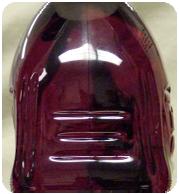 It's also a great problem solver. For example, there was the case of the bulging logo. What appeared to be a completely successful redevelopment of a juice bottle to make it more lightweight and ergonomic suddenly came to an abrupt halt during production rollout. During the filling process, the bottle's logo bulged out in a highly unaesthetic way — an unanticipated problem. Turns out the customer's filler machine was applying too much pressure to the bottle.
It's also a great problem solver. For example, there was the case of the bulging logo. What appeared to be a completely successful redevelopment of a juice bottle to make it more lightweight and ergonomic suddenly came to an abrupt halt during production rollout. During the filling process, the bottle's logo bulged out in a highly unaesthetic way — an unanticipated problem. Turns out the customer's filler machine was applying too much pressure to the bottle.
The PTI engineers went back to the drawing board. The created three different design options and then, using FEA, simulated their behavior under the pressures applied by the filler. They picked the top performer, cut a blow mold, and solved the problem quickly, efficiently and at a low cost.
Although PTI is very happy with the capabilities of its HPC-based capabilities for modeling and simulation, both Puvak and Momany agree that PTI could use a lot more computing power.
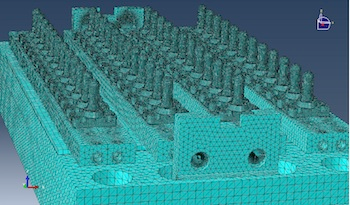 Says Momany, "If we had access to a supercomputer system, as well as the required support, without having to make a capital expenditure, we would have the potential to simulate the entire product life cycle of our packages. These complex, large models would allow us to factor in such things as conveyors, palette loads, shipping considerations, environmental concerns, and even consumer usage. Given the initiatives underway in this country to help small manufacturing companies like ours, perhaps this is a dream we can realize in the very near future."
Says Momany, "If we had access to a supercomputer system, as well as the required support, without having to make a capital expenditure, we would have the potential to simulate the entire product life cycle of our packages. These complex, large models would allow us to factor in such things as conveyors, palette loads, shipping considerations, environmental concerns, and even consumer usage. Given the initiatives underway in this country to help small manufacturing companies like ours, perhaps this is a dream we can realize in the very near future."










